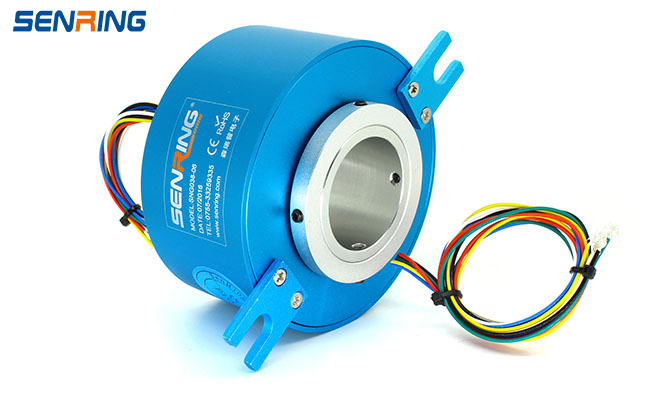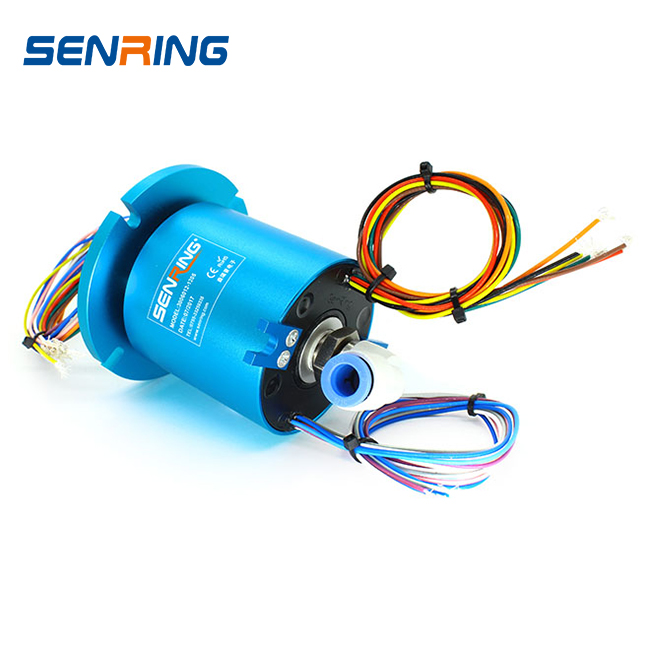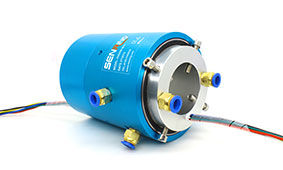What are the drawbacks of slip rings and carbon brushes?
The main drawback of slip rings and carbon brushes is that they are subject to wear and tear, which can cause sparking and electrical arcing. This can
lead to reduced efficiency, increased maintenance costs, and even damage to the equipment. Additionally, slip rings and carbon brushes are not suitable
for use in harsh environments or with high levels of contamination, as this can accelerate wear and tear.
Through hole slip ring with flange and carbon brushes, while widely used for electrical connections in rotating systems, have several drawbacks:
Slip Rings:
Wear and Maintenance: Slip rings suffer from wear over time due to the friction with the brushes. This wear necessitates regular maintenance and replacement,
impacting the overall reliability of the system.

Limited Rotational Speed: High rotational speeds can lead to increased wear on slip rings and brushes, limiting their application in high-speed or
high-frequency rotation scenarios.
Environmental Susceptibility: Exposure to dust, dirt, moisture, or other contaminants can affect the performance and longevity of slip rings, potentially leading to
electrical noise or intermittent connectivity issues.
Complexity in Signal Transmission: Transmitting multiple signals or high-frequency data through slip rings can be challenging due to potential signal interference
and degradation over long-term usage.
Carbon Brushes:
Carbon Dust Generation: Carbon brushes can generate dust during operation, which may pose cleanliness and contamination concerns, particularly
in sensitive environments such as laboratories or manufacturing facilities.

Wear and Replacement: Similar to capsule electrical slip ring, carbon brushes suffer from wear and require periodic replacement, leading to maintenance
requirements and potential downtime for the equipment.
Electrical Noise and Interference: In certain applications, carbon brushes can introduce electrical noise or interference due to their contact with the rotating
surface, affecting the quality of transmitted signals or power.
Limited Current Capacity: High current applications may surpass the capacity of carbon brushes, resulting in overheating, premature wear, or reduced
operational lifespan.
In summary, while slip rings and carbon brushes provide valuable electrical connectivity in rotating systems, their drawbacks include wear-related maintenance,
limitations in rotational speed and signal transmission, susceptibility to environmental factors, generation of carbon dust, and potential electrical noise or
interference issues, all of which necessitate careful consideration when choosing these components for specific applications.
For more details on slip ring products, please view :https://www.senring.com/info/industry/2023-12-28/107.html
FAQ questions:
1.What is the use of through bore slip ring?
2.What is difference between slip ring and split ring?
3.What is capsule slip ring and is used for?
5.What is the service life and reliability of high-speed slip rings?
- How to connect capsule electrical slip ring wire?
-

- 15-11-2023
- The wiring methods of cap-type conductive slip rings can vary according to specific applications and circuit requirements. Generally speaking, the wiring method
- more+

 RESOURCES
RESOURCES GET A QUOTE
GET A QUOTE





